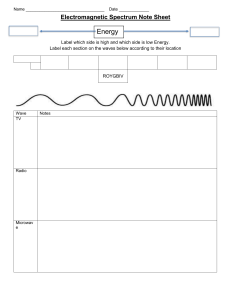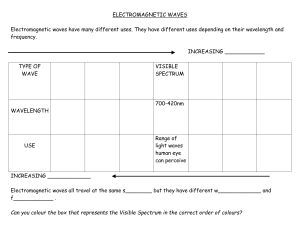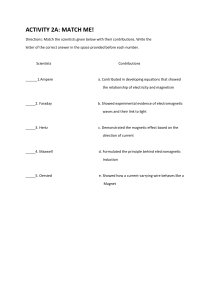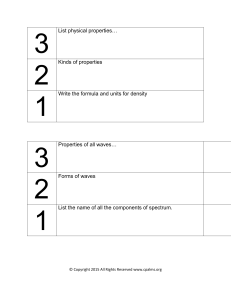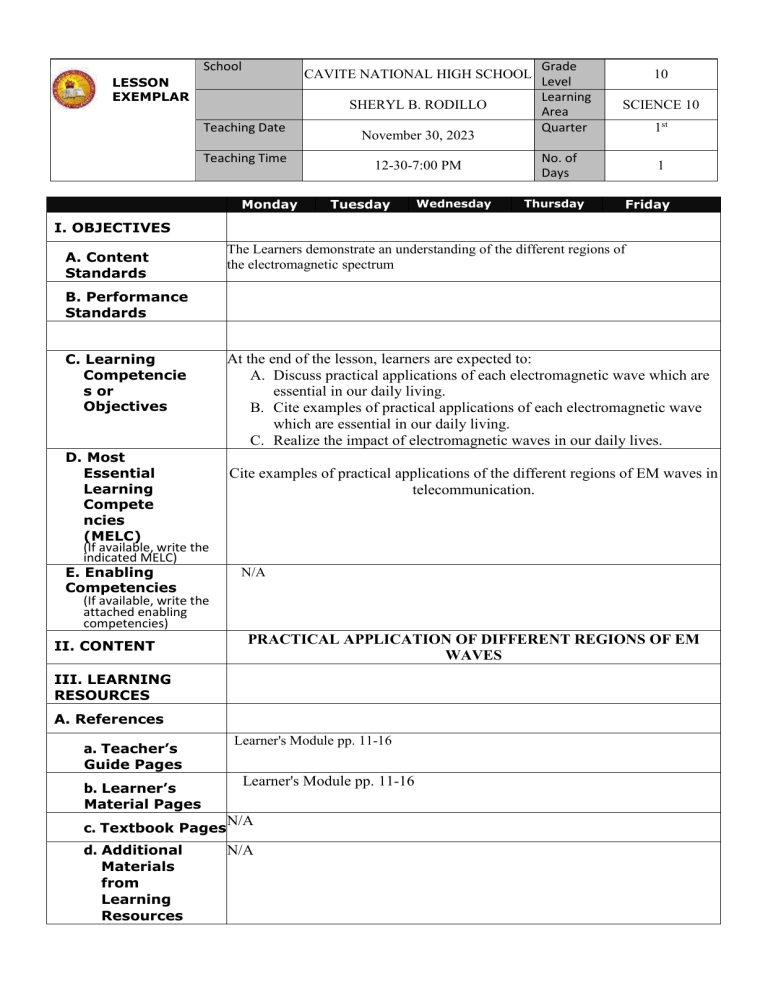
School CAVITE NATIONAL HIGH SCHOOL LESSON EXEMPLAR SHERYL B. RODILLO Teaching Date Teaching Time Monday November 30, 2023 12-30-7:00 PM Tuesday Wednesday Grade Level Learning Area Quarter 10 SCIENCE 10 1st No. of Days Thursday 1 Friday I. OBJECTIVES A. Content Standards The Learners demonstrate an understanding of the different regions of the electromagnetic spectrum B. Performance Standards C. Learning Competencie s or Objectives D. Most Essential Learning Compete ncies (MELC) (If available, write the indicated MELC) E. Enabling Competencies (If available, write the attached enabling competencies) II. CONTENT At the end of the lesson, learners are expected to: A. Discuss practical applications of each electromagnetic wave which are essential in our daily living. B. Cite examples of practical applications of each electromagnetic wave which are essential in our daily living. C. Realize the impact of electromagnetic waves in our daily lives. Cite examples of practical applications of the different regions of EM waves in telecommunication. N/A PRACTICAL APPLICATION OF DIFFERENT REGIONS OF EM WAVES III. LEARNING RESOURCES A. References a. Teacher’s Guide Pages b. Learner’s Material Pages Learner's Module pp. 11-16 Learner's Module pp. 11-16 c. Textbook Pages N/A d. Additional Materials from Learning Resources N/A B. List of Learning Resources for Development and Engagement Activities https://www.youtube.com/watch?v=CQV8PWRBhDc IV. PROCEDURES A. Introduction A. DAILY ROUTINE 1. Prayer 2. Checking of Attendance 3. Grouping B. Recall Direction: Look at the picture below, write the name of the correct Electromagnetic wave corresponding to the letters on the picture. You may refer to your answer for numbers 1-7 from the box. MOTIVATION Word Search Direction: Look for the name of devices hidden in the puzzle below. The words may be placed vertically, horizontally, diagonally, or even backwards. Write ten (10) terms you found in the word box below. B. Development Guide question: What do you think are these devices for? What form of EM waves make them work? Learning Task 1 “Behind the White Light” What you need: ▪ water ▪ sunlight or flashlight ▪ shallow pan ▪ small mirror ▪ piece of paper or white surface What to do: 1. Before doing this activity, read the guide questions below. 2. Fill the shallow pan with water about half full. 3. Put the mirror into the water inside the pan at an angle. 4. Position the pan so that sunlight/flashlight shines directly where the mirror is under water. You may have to shift the mirror to find the right angle. 5. Hold the white paper above the mirror. It would be easier to see if the room is dark. 6. Adjust the angle of the mirror until you see a rainbow. Observe. Prism is a triangular piece of glass that is used to separate white light. From the activity above, which materials served as a prism? _________________________________________ B. Explain why white light splits up into different colors when it goes through a prism? _______________________________________________________________ ____________ C. Write down the color spectrum you observed in proper order from top to bottom. _______________________________________________________________ ____________ 10 D. What color bends the least? _______________________________________________________________ ___ E. What color bends the most? _______________________________________________________________ ___ Learning Task 2 Radio Transmitter and Receiver Parts Materials: Diagrams of radio transmitter and receiver parts Instructions: 1) Study the diagrams of a radio transmitter and receiver. 2) Identify and label the different parts of each device. 3) Explain the function of each part in the transmission and reception of radio waves. 1. Generalization Direction: Complete the flow chart showing the processes of radio broadcasting and communication using the words below. Do this on a separate sheet of paper. Radio waves are generated artificially by an electronic device called a transmitter, which is connected to an antenna which radiates the waves. They are received by another antenna connected to a radio receiver, which processes the received signal. 2. Application How do electromagnetic waves impact our everyday living? C. Assimilation POST TEST Direction: Read the following questions carefully and choose the letter of the correct answer. 1. Which of the following is the correct application of radio waves? A. camera auto focusing C. diagnosis of bone fractures B. radio broadcasting D. sterilization of medical instrument 2. Which band of frequency is suitable for communication over great distances? A. low frequency C. very low frequency B. medium frequency D. extremely low frequency 3. Which among the following transforms AF signal and RF carrier wave to a modulated carrier wave A Amplifier C. Modulator B. Antenna D. Demodulator 4. Which among the following transmits and receives radio waves? A. Amplifier C. Modulator B. Antenna D. Demodulator 5. How do electromagnetic waves impact our everyday living?? A. EM has no use in our everyday lives. B. EM has a vast range of practical everyday applications. C. EM moves in the direction of the vibrations of both the electric and magnetic oscillating field vectors. D. EM moves in any direction. 1. REFLECTION Write this portion in the learner’s journal. I understand that ________________ I realize that _________________ I want to learn more about _________________ Prepared by: Approved by: Noted by: SHERYL B. RODILLO Teacher I-Science Department NESTOR DONIÑA Master Teacher I JOCELYN P. IBAÑEZ Head Teacher VI

